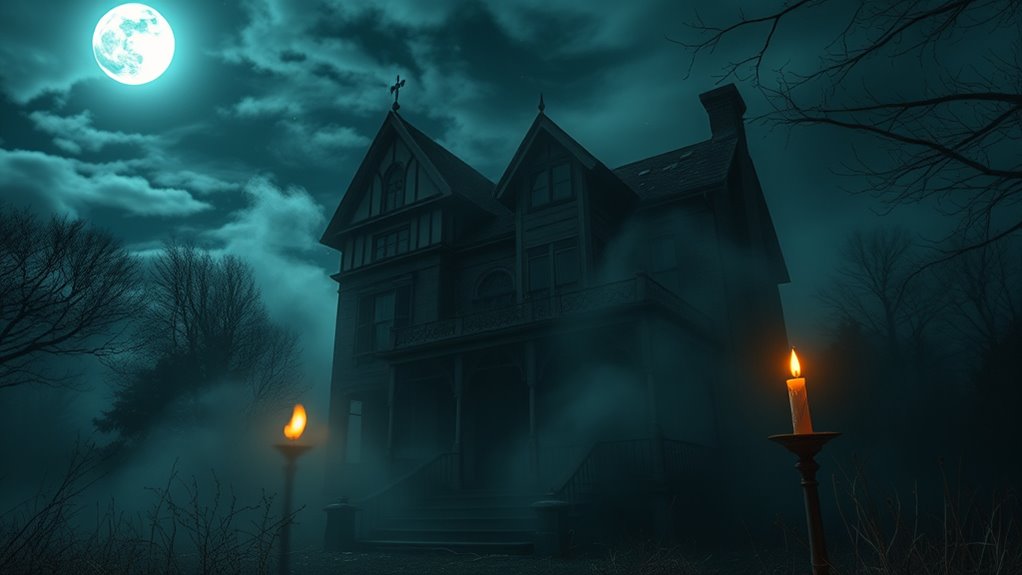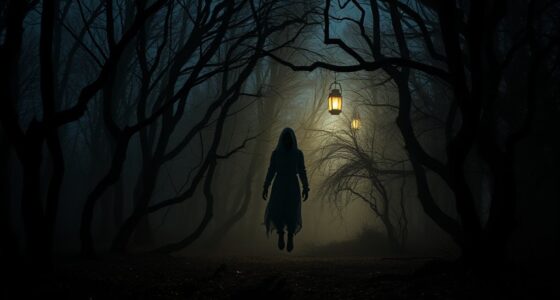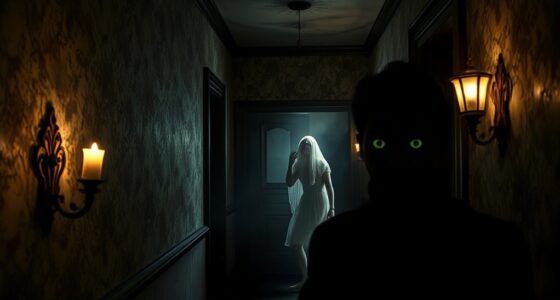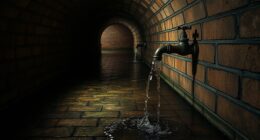Science can explain many ghost encounters by highlighting psychological, environmental, and cultural influences. Emotional states, suggestion, and group dynamics can distort your perceptions, making supernatural experiences feel real. Conditions like sleep paralysis or exposure to mold can cause vivid hallucinations that people interpret as ghostly encounters. Additionally, electromagnetic fields and infrasound in certain locations can evoke anxiety and illusions. Understanding these factors can give you a clearer picture of what really shapes ghost phenomena, and there’s much more to uncover.
Key Takeaways
- Scientific explanations suggest many ghost sightings stem from psychological factors, including suggestion, emotional states, and cultural narratives.
- Environmental influences, such as electromagnetic fields and infrasound, can induce hallucinations that resemble ghostly encounters.
- Sleep paralysis is a well-documented phenomenon that can produce vivid hallucinations, often misinterpreted as ghost experiences.
- The presence of mould in supposedly haunted locations can lead to distorted perceptions, contributing to beliefs in ghosts.
- Critical thinking and awareness of perceptual phenomena, like pareidolia, are essential in evaluating ghost claims scientifically.
Overview of Ghost Encounters
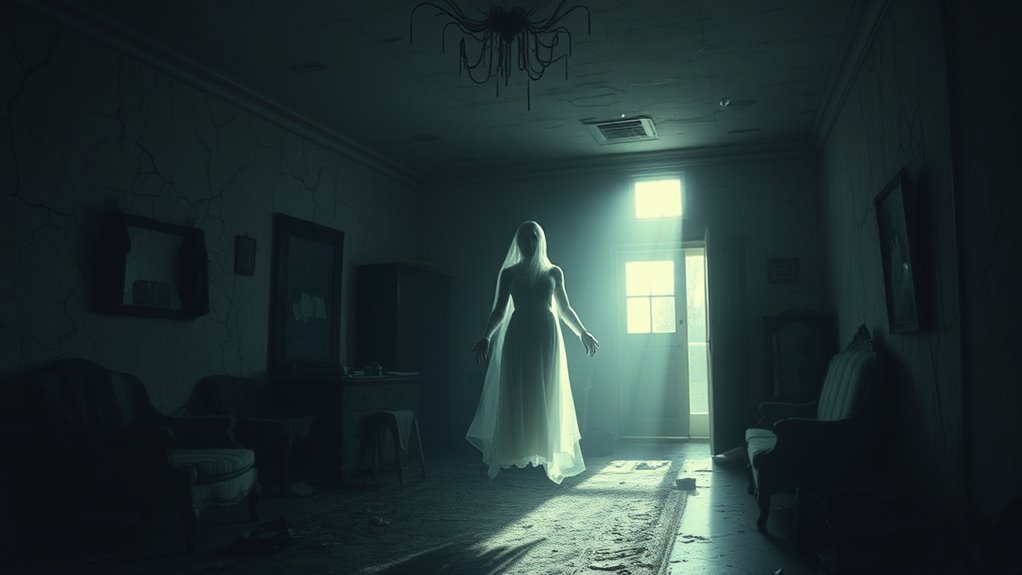
When you hear about ghost encounters, you might think of spooky stories and haunted houses, but these experiences are more common than you might expect. Nearly 20% of Americans report ghost sightings, indicating a significant number of people who believe they’ve encountered the supernatural.
A 2021 poll revealed that 41% of American adults hold paranormal beliefs, demonstrating a cultural acceptance of these phenomena.
However, many ghost encounters can often be explained through scientific explanations. Reports may stem from natural misinterpretations or psychological factors, such as hallucinations and pareidolia.
Many ghost encounters can be attributed to natural misinterpretations or psychological factors like hallucinations and pareidolia.
Cultural narratives and personal experiences shape how individuals interpret these sightings, leading to diverse understandings of what ghosts truly are in different societies.
Psychological Explanations

Psychological explanations play an essential role in understanding ghost encounters. Your perceptions can be heavily influenced by psychological factors, leading to various interpretations of what you experience.
Think about how:
- Your emotional state can amplify feelings of fear or anxiety, making you more susceptible to seeing ghosts.
- Cultural narratives shape your beliefs, causing you to interpret normal sensations as paranormal phenomena.
- Context matters; knowing a location is haunted can heighten your awareness, leading to misinterpretations of everyday stimuli.
These elements can distort your experiences, creating a framework where the supernatural feels real.
The Role of Sleep Paralysis
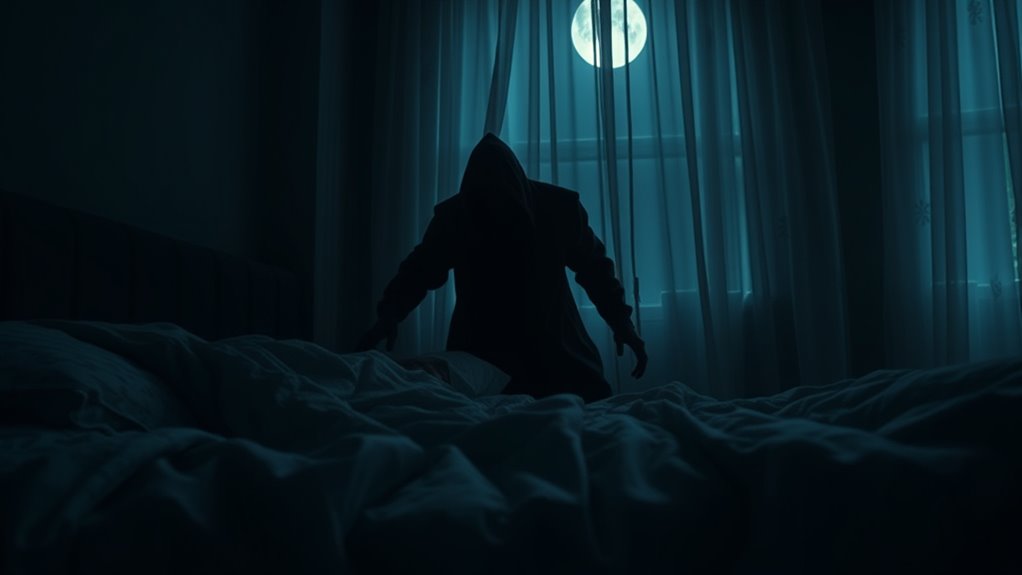
Have you ever woken up and felt completely unable to move, as if something was pressing down on your chest?
This experience, known as sleep paralysis, often comes with vivid hallucinations that can make you feel like you’re not alone.
Understanding this condition can shed light on why some people mistake these episodes for ghostly encounters.
Sleep Paralysis Explained
Although many people associate ghostly encounters with the supernatural, sleep paralysis offers a scientific explanation for these eerie experiences. This phenomenon occurs during REM sleep when your brain struggles to shift between sleep and wakefulness, leaving you unable to move or speak.
Many report feelings that can be terrifying, including:
- A heavy pressure on your chest
- The sensation of a dark presence in the room
- Vivid hallucinations that seem all too real
Lacking knowledge about sleep paralysis, you might misinterpret these experiences as supernatural, fueling the belief in ghosts.
Scientific evidence shows that this condition often begins in childhood or adolescence, with triggers like stress or sleep deprivation, making it easier to understand why people believe in ghosts.
Hallucinations During Episodes
During episodes of sleep paralysis, many people experience vivid hallucinations that can feel disturbingly real. This phenomenon occurs when your brain remains active during REM sleep, but your body is unable to move.
You might sense a presence in the room or feel physically restrained, leading to misunderstandings that these experiences are ghostly encounters. Scientific studies show that about 30% of individuals report such hallucinations during sleep paralysis.
The overlap of waking and dreaming creates frightening visions, like shadowy figures or eerie entities. Without knowledge of sleep paralysis, it’s easy to interpret these terrifying episodes as paranormal activity, reinforcing beliefs in ghosts.
Understanding this condition can help demystify these unsettling experiences.
Environmental Factors and Mould
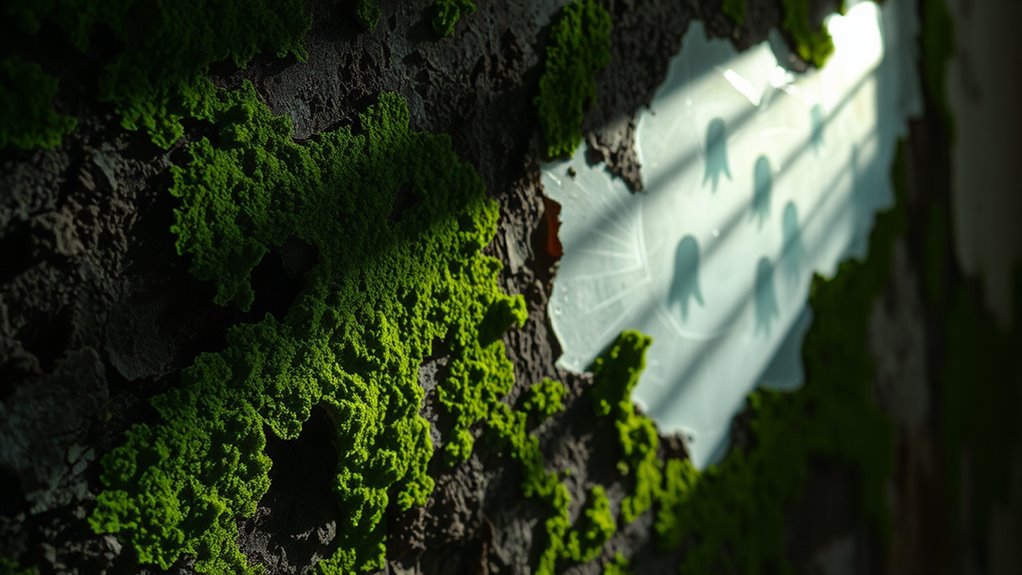
Have you ever wondered if mould in your environment could be messing with your mind?
Research shows that exposure to certain types of mould can lead to hallucinations and distorted perceptions, making you question what’s real.
This connection between mould and your experiences might shed light on some ghostly encounters you’ve heard about.
Mould-Induced Hallucinations
When you step into an old, musty building, you mightn’t realize that the mold lurking in the corners could be influencing your perception of reality.
Certain molds, like Aspergillus and black mold, release mycotoxins that can spark hallucinations and paranoia. This could explain why some people claim to experience paranormal activity.
- You might see shadows darting by.
- Whispers echo in empty rooms.
- A chilling feeling wraps around you.
Research shows a significant mold presence in supposedly haunted locations, suggesting that these environmental factors could distort your sense of what’s real. Additionally, emotional neglect experienced by individuals in such environments may exacerbate feelings of fear and confusion.
If you’re experiencing fatigue and visual disturbances, you could be misinterpreting normal phenomena as ghostly encounters influenced by mold-induced hallucinations.
Environmental Influences on Perception
Although you mightn’t realize it, environmental factors like mold can considerably shape your perception of reality. Certain molds, such as Aspergillus and Stachybotrys, release mycotoxins that can lead to hallucinations and paranoia, which might explain some ghost sightings.
When you’re exposed to mold, you may experience fatigue and cognitive issues, creating an unsettling atmosphere that could be mistaken for paranormal activity. Studies show a significant difference in mold prevalence between locations reported as haunted and those without such claims.
Additionally, environmental factors like air drafts and sudden temperature changes can produce sensations interpreted as ghostly encounters. The psychological impact of mold exposure can heighten your fear responses, making ordinary occurrences seem supernatural.
The Impact of Suggestion and Belief
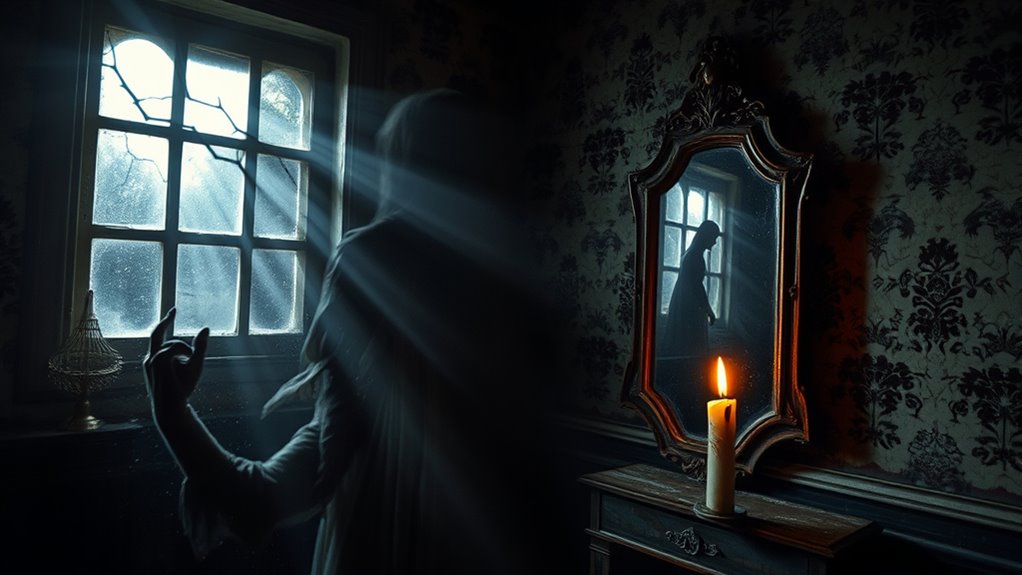
While many dismiss ghostly encounters as mere tricks of the mind, the impact of suggestion and belief plays a crucial role in shaping these experiences. People often find themselves in environments deemed haunted, where psychological priming amplifies their fears and anxieties. This can lead to a heightened perception of the paranormal.
Consider how:
- Cultural narratives shape your expectations, making you more likely to interpret ordinary events as supernatural.
- Group dynamics create a shared belief that can intensify interpretations of strange occurrences.
- Higher levels of belief in the paranormal can result in inattentional blindness, skewing your perception of reality.
In these ways, suggestion and belief can transform your experiences and lead you to see ghosts where there may be none.
Misinterpretation of Evidence
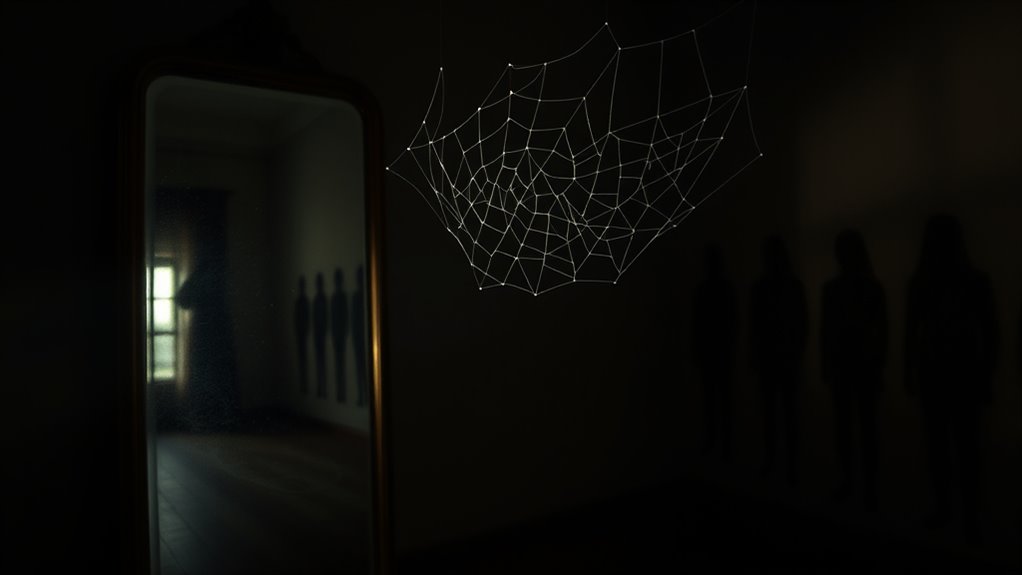
The influence of suggestion and belief can easily lead to misinterpretations of evidence during ghost investigations. Many tools used in ghost hunting lack a solid scientific basis, which can skew results.
For example, you might hear unexplained noises and assume they’re spirits, but they could stem from environmental factors or mechanical failures. Security camera footage often misleads as lighting and motion can create optical illusions, making ordinary events appear supernatural.
The infamous “orbs” captured in videos are usually just dust reflecting light, not evidence of ghostly entities. Additionally, mechanical failures in electronic devices can explain occurrences like flying objects in ghost sightings, adding another layer of complexity to the misinterpretation of evidence in the quest for the science behind ghosts.
Scientific Investigations of Ghost Phenomena
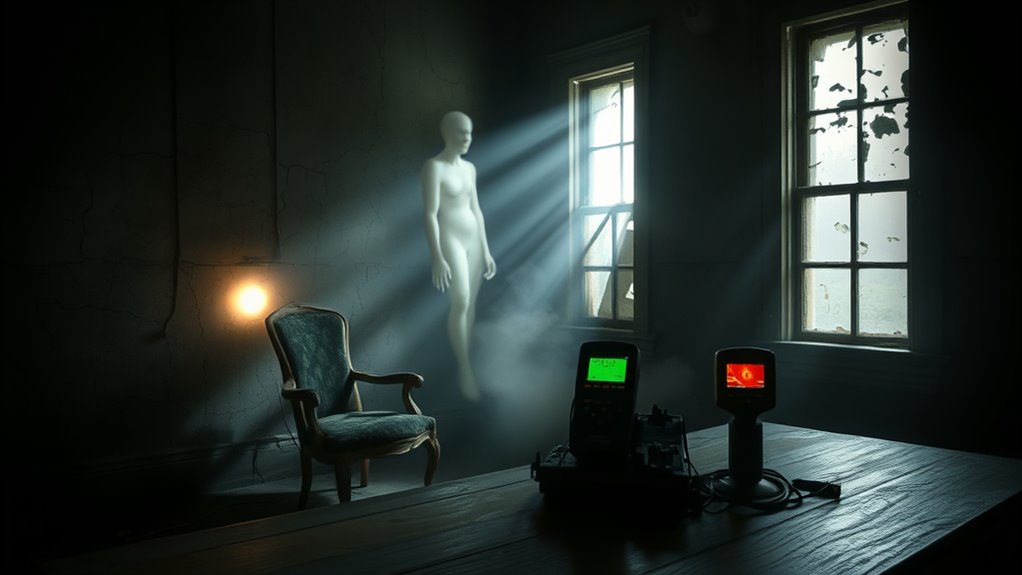
As researchers explore the world of ghost phenomena, they uncover intriguing connections between environmental factors and human perception.
These investigations suggest possible explanations for ghostly experiences and encourage critical thinking about what we perceive.
- Electromagnetic fields can trigger hallucinations, leading you to see or feel things that aren’t there.
- Infrasound, present in haunted locations, may induce anxiety and optical illusions.
- The power of suggestion can shape your experience, making even an artificial haunted room feel terrifying.
You might feel a chill as studies reveal significant mould differences between haunted and non-haunted places, hinting that the environment could influence ghost sightings.
All these factors challenge your understanding of ghosts and encourage a more scientific approach to the unexplained.
Cultural Narratives and Perceptions
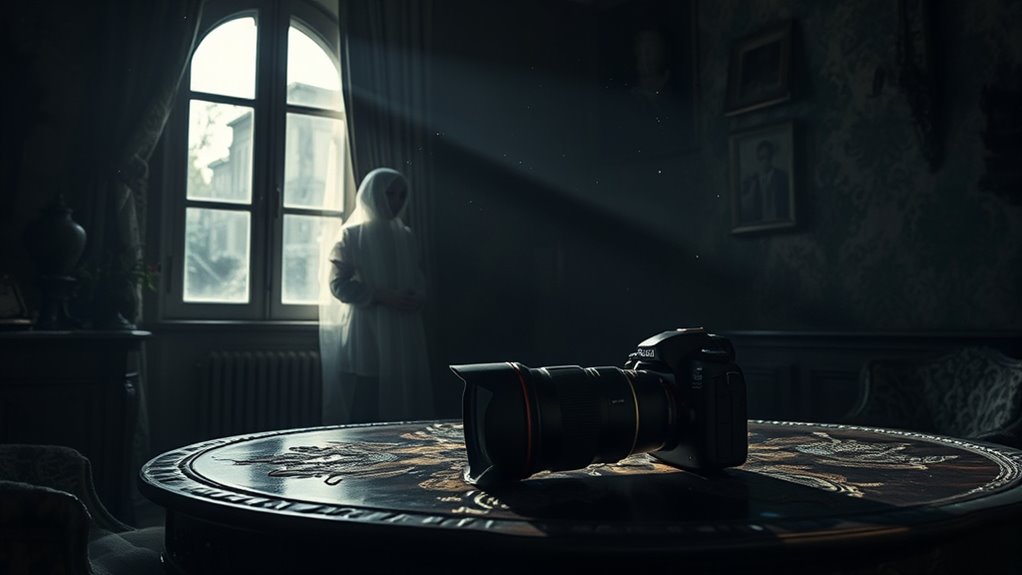
Cultural narratives about ghosts shape how you perceive these phenomena, revealing deeper societal fears and hopes surrounding mortality. Your understanding of ghost beliefs often stems from historical contexts, where spirits were seen as having unfinished business.
This perspective has evolved, reflecting societal shifts, such as the rise of spiritualism in the 19th century, which emphasized communication with the deceased. Reports of hauntings typically feature unseen entities, demonstrating a shared cultural interpretation across various societies.
Each culture offers unique narratives that resonate with its beliefs about life after death. By exploring these cultural narratives, you can better grasp how they influence your perceptions of ghostly encounters and the emotional comfort people seek from their departed loved ones.
Critical Thinking in Evaluating Ghost Claims
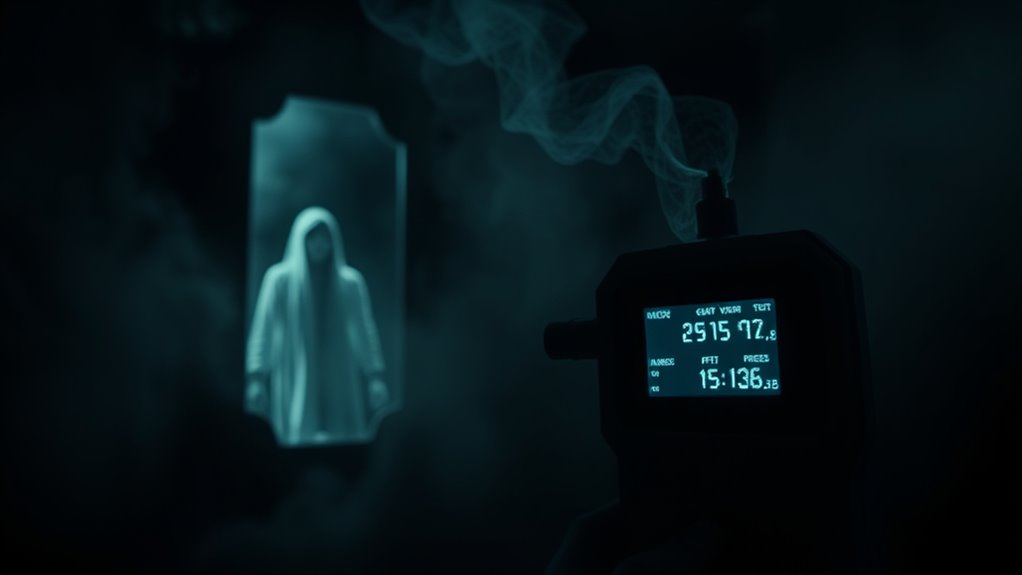
While exploring ghost claims, it’s crucial to apply critical thinking skills that help you distinguish between fact and fiction. Simply accepting stories can lead to misunderstanding.
To effectively evaluate these claims, consider:
To assess ghost claims, reflect on psychological influences, perceptual tricks, and cultural narratives shaping your experiences.
- The impact of psychological factors shaping your beliefs and experiences.
- How perceptual phenomena, like pareidolia, can trick your mind into seeing what isn’t there.
- The influence of cultural narratives that color your perceptions of the paranormal.
Frequently Asked Questions
Is There Any Scientific Evidence of Ghosts?
You won’t find any scientific evidence supporting the existence of ghosts.
Numerous studies reveal that claims of ghost sightings often stem from psychological factors, misinterpretations of sensory data, or environmental influences.
While many people believe they’ve experienced something paranormal, anecdotal evidence isn’t enough for scientific validation.
Without solid, empirical proof, the existence of ghosts remains unsubstantiated, leading researchers to conclude that extraordinary claims need extraordinary evidence, which simply isn’t present in this field.
Can Science Explain the Supernatural?
Imagine walking through a dark forest, shadows dancing around you, and a chill creeping up your spine.
Can science explain the supernatural? It often seeks to demystify what we perceive as otherworldly. Through rigorous investigation, it uncovers natural explanations for strange occurrences, like infrasound causing unease or mold leading to hallucinations.
These findings challenge our perceptions and remind you that what seems supernatural may simply be a product of the natural world.
Does Science Believe in Paranormal Activity?
Science doesn’t believe in paranormal activity because it relies on evidence and reproducibility.
You’ll find that studies often attribute experiences labeled as paranormal to psychological factors or environmental influences.
While many people report feeling or seeing something supernatural, those experiences lack scientific validation.
Skeptics argue that extraordinary claims require extraordinary evidence, and anecdotal accounts simply aren’t enough to convince the scientific community of the existence of ghosts or other paranormal phenomena.
Do Ghosts Violate the Laws of Physics?
Did you know that about 30% of people claim to have experienced a ghostly encounter?
When it comes to the laws of physics, ghosts do seem to violate them. They’re often described as moving through solid objects or appearing without any physical form, which science can’t support.
Additionally, the lack of biological functions like aging contradicts established principles, making it hard to reconcile ghost claims with our understanding of the physical world.
Conclusion
In the end, while the spectral whispers of ghosts may linger in our imaginations, science casts a bright light on the shadows of our fears. By unraveling the threads of psychology, environmental influences, and cultural beliefs, you can see that what feels like the supernatural often has a natural explanation. So, next time you feel a chill or hear a creak, remember: it’s not always a ghost; sometimes, it’s just the wind playing tricks on you.
